Please Take Note: This is a review of the final game, but it might change slightly based on the success of the Kickstarter campaign. The game is being reviewed on the components and the rules provided with the understanding that “what you see is not what you might get” when the game is published. If you like what you read and want to learn more, we encourage you to visit the game’s website or visit the Kickstarter campaign. Now that we have all that disclaimer junk out of the way, on with the review.

The Basics:
- For ages 10 and up (publisher suggests 14+)
- For 1 to 4 players
- Approximately 60 minutes to complete
Geek Skills:
- Counting & Math
- Logical & Critical Decision Making
- Reading
- Pattern/Color Matching
- Strategy & Tactics
- Risk vs. Reward
- Visuospatial Skills
- Cooperative & Team Play
- Hand/Resource Management
Learning Curve:
- Child – Moderate
- Adult – Easy
Theme & Narrative:
- Manipulate the castle to rule the kingdom
Endorsements:
- Gamer Geek approved!
- Parent Geek approved!
- Child Geek approved!
Overview
American lawyer, U.S. Representative, social activist and a leader of the Women’s Movement, Bella Abzug, said “I spend all day figuring out how to beat the machine and knock the crap out of the political power structure.” A task easier said than done. In this game, players will be attempting to do the same as Ms. Abzug, manipulating the machine and adjusting the power structure in hopes of one day ruling the kingdom.
Blackstone Castle, designed by Harvey Cornell and to be published by Dragon Phoenix Games, will reportedly be comprised of one game board, 32 Machination cards, 32 Power cards, 32 Guild cards, 72 Vassal cards, 20 Household cards, four Assassin/Saboteur cards, four Wild Vassal cards, four Family cards, eight Intrigue tokens, 20 Knight tokens, 20 Wizard tokens, 10 Castle (completion) tokens, four Dog cards for Rats in the Walls, 25 Rats in the Walls cards, and one First-Player marker. As this is a review of a prepublished game, I cannot comment on the component quality. The artwork in the game works as far as helping the player understand what the cards are representing, but they do not carry the game’s theme very well. “Functional” is how I would describe it.
Welcome to Blackstone
To set up the game, first place the game board in the middle of the playing area and then shuffle the Vassal cards. Draw and place 13 Vassal cards, placing them to the game board spaces in the grid that have a white border. Take the remaining Vassal cards, cut into roughly four equal decks, and place one deck on each of the four corners of the game board. At this time select one of the four corners of the game board to be your Replenishment deck.
Second, give each player one “Order of Events”, two “Kings”, one “Wizard”, and one “Knight” Household cards. These are the player’s starting tableau which are placed in front of the player, face-up, at this time. Place any remaining and unused Household cards to the side for now.
Third, give each player one Knight and one Wizard token. Place all remaining tokens (Knight, Wizard, and Castle) in separate piles close to the game board. These are the supply piles.
Fourth, shuffle the Guild cards, Power cards, and Machination cards as separate decks. Deal to each player two Guild cards. These go into the player’s hand (which is not the same as the player’s tableau). Place the Guild, Power, and Machination decks face-down and to one side of the game board. These are the Guild, Power, and Machination draw decks for the duration of the game.
That’s it for game set up. Determine who will be the first player, give them the First-Player marker, and begin.
Castles, Politics, and Plots
Blackstone Castle is played in rounds and turns with no set number of rounds in a game. A player’s turn is summarized here.
Step One: Recall Intrigue Agents
If the active player placed any Intrigue tokens or a face-down card they placed on their last turn, they are now removed. However, the active player has the option of keeping an Intrigue token in play if it’s currently located on a face-down card. In which case, the Intrigue token will be removed when the card is activated.
Step Two: Muster Your Knights and Wizards
The active player collects one Knight and one Wizard token per “Knight” and “Wizard” Household cards for completed “Knight” and “Wizard” cards in their tableau. The total number of tokens that can be collected is limited to the number of “Kings” currently in play in the player’s tableau.
Step Three: Order Your Knights and Wizards
The active player may now use their collected Knight and Wizard tokens to complete the following actions in any order they like and as many times as possible (per the player’s strategy):
Manipulate Vassals
The active player spends their Knight and Wizard tokens, using them like currency, to activate actions listed on their Household cards. They will move around and off the game board, which is comprised of spaces in rows and column. The letters for the rows and columns are used when determining if a card collected meets certain requirements.

Knights allow the active player to move the Vassal cards into different positions, sliding them up, down, left, and right one space on the game board. The moved Vassal card cannot occupy the same space as another Vassal card. They can also use them to “retain” a Vassal card. This allows the active player to remove the Vassal card from the game board and place it under the Knight card as part of the active player’s tableau. The removed Vassal card is then refilled from any Vassal deck on the four corners. The last action the Knight can take is drawing one Task card from the Guild, Power, or Machination draw decks (but it’ll cost the player two Knight tokens to do so).
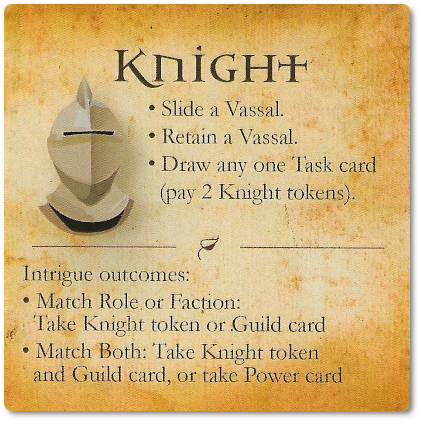
Wizards “teleport” (that’s the way we saw it, thematically speaking) Vassal cards, swapping the position of one Vassal card with another. The swapped Vassal cards must be orthogonally adjacent to one another. The Wizard card can also “transform” a Vassal card, allowing the active player to flip the Vassal card to its other side, but it remains in the same space. The last action the Wizard can take is draw one Task card from the Guild, Power, or Machination draw decks.
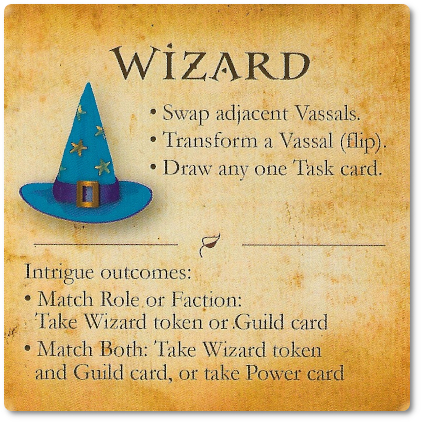
Complete Tasks
If the player can complete the requirements of two different Vassal cards on the game board, they may do so now by using Castle completion tokens to mark the Vassal cards in use.
Each Vassal card displays a Faction, a Role, and a hint of what the other side of the card has on it (if you want to flip it).
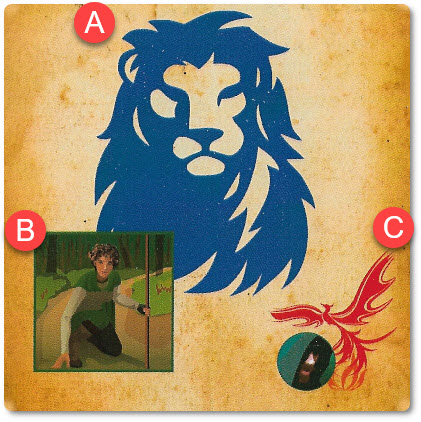
A) Faction symbol
B) Role symbol
C) Displays what is on the other side of the Vassal card
These Vassal cards are used to meet the requirements of the Guild, Power, and Machination cards.
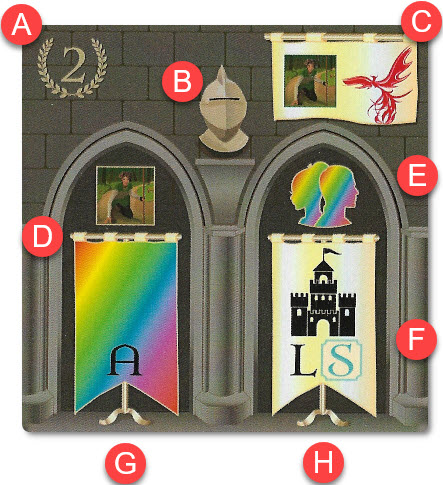
A) Victory points earned
B) Reward for completing the task
C) Additional requirements, but only if the card is NOT your first completed task of this type (Knight or Wizard…in this case, Knight)
D) If the banner is multi-colored, it indicates it’s a wild Faction (any faction can meet the goal) – the banner to the right has a specific faction requirement (Castle)
E) If the silhouette is multi-colored, it indicates it’s a wild Role (any role can meet the goal) – the silhouette to the left has a specific Role
F) The first letters in the banners indicated from what location on the game board the Vassal cards must be collected. The second letter is an optional restraint, used only in the advanced game.
G) The first requirement that must be met (specific Role, but any Faction from the A column)
H) The second requirement that must be met (any Role, but a specific Faction from the L column)
Step Four: Assign New Vassals
The active player draws one new Vassal card from the Replenishment deck for each Vassal card that was completed. The first card to be replaced is the one in the highest row.
Step Five: Assign Intrigue Agents
If the active player completed a Task card, they may now place one Intrigue marker on any of the completed “Knight”, “Wizard”, or “King” Task cards. The Intrigue maker should match the face-up Vassal card’s faction or role symbol (or both).
However, if the active player did not complete any Task cards this turn, they may now place one Task card from their hand face-down on the table in front of them, placing one Intrigue marker on top of it.
If a card the active player marked is used by an opponent later in the round, rewards are given. These are listed on the cards.
Step Five: Check Limits
The number of tokens and cards the player may have is determined by the number of completed King cards they have. If the player has more Knight tokens, Wizard tokens, Task cards (in hand), and retained Vassal cards (in the tableau) than King cards, they must discard any that exceed the King card number at this time. There is one exception to this rule. The active player may keep completed Knight, Wizard and Ploy cards that exceed the number of completed Kings, but the active player does not receive any victory points.
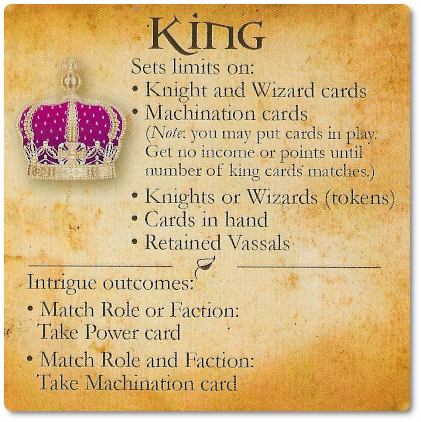
This completes the player’s turn. The next player in turn order sequence now takes their turn starting with step one noted above. When all the players have had their turn, a new round begins.
Other Cards of Note
Blackstone Castle has a few other cards that are used in the game, but play a minor role. The Special cards (“Assassins” and “Saboteurs”) that can be added to the game if the player’s like. These cards create additional puzzles to solve for the players as they manipulate Vassal cards on the game board. Family cards can also optionally be used, giving each player a special ability. Finally, the Ploy cards, which are worth the most points, but do not give the player much in the way of additional options to consider using as tactics.
Owning the Castle
The endgame is triggered when any player on their turn earns 21 or more victory points. The round is now finished, ensuring all players have an equal number of turns. When the last player has taken their turn, the points are counted. The player with the most points wins the game.
Game Variants
A number of different ways to have fun with the base game (described above) are provided that put different twists into the game play. Each are summarized here.
- The King’s Quest: a cooperative game variant for two-players, challenging the team to earn 50 or more victory points. The Rat, Cat, Duchess, and Plague cards are introduced into the game play. If the there are ever 12 active Rats in the castle before the team earns their victory points, they lose!
- The Queen’s Quest: a competitive game variant for two to four-players, where the game play is more or less the same, but the players are attempting to collect sets of Vassal cards to earn victory points.
- The Wizard’s Quest: another competitive game variant for two to four-players, where the players are attempting to get ride of cards instead of collecting them. An interesting twist that forces the players to come up with a completely different strategy.
- The Puzzle Master’s Quest: a cooperative game variant for two-players, where the team must work together to create a very specific set up on the game board by manipulating Vassal cards.
- Advanced King’s Quest: a competitive game variant for two to four-players, where players must collect 30 or more victory points to win instead of 21.
- Solo King’s Quest: A solitaire game variant where the player is attempting to earn 25 or more victory points before there are too many rats in the walls.
To learn more about Blackstone Castle, visit the game’s website or visit the Kickstarter campaign.
Final Word
 Blackstone Castle is not a terribly heavy game, but it’s abstract in nature and there are many moving pieces that must all come together. This made the game more difficult to understand, resulting in only our older and more experienced Child Geeks having a firm enough grasp on the game play. Make no mistake, Blackstone Castle isn’t terribly difficult, but it can be tricky to teach all the different ways the cards are manipulated. According to one Child Geek, “Once you understand that it is all about moving, shifting, and grabbing the cards at the right time, this game is pretty easy to play.” Very true, but that learning curve is not an easy hill to climb. Another Child Geek said, “What I really like about this game is that it’s like a moving puzzle. I see the pieces I need, and now I just need to move them into position. Really frustrating, though, when you are short just one Knight or Wizard to get the job done!” Despite the Child Geeks having to work a bit harder to learn the game and their non-stop groaning that you never have enough knights when you really need them, they all agreed that Blackstone Castle was a lot of fun to play.
Blackstone Castle is not a terribly heavy game, but it’s abstract in nature and there are many moving pieces that must all come together. This made the game more difficult to understand, resulting in only our older and more experienced Child Geeks having a firm enough grasp on the game play. Make no mistake, Blackstone Castle isn’t terribly difficult, but it can be tricky to teach all the different ways the cards are manipulated. According to one Child Geek, “Once you understand that it is all about moving, shifting, and grabbing the cards at the right time, this game is pretty easy to play.” Very true, but that learning curve is not an easy hill to climb. Another Child Geek said, “What I really like about this game is that it’s like a moving puzzle. I see the pieces I need, and now I just need to move them into position. Really frustrating, though, when you are short just one Knight or Wizard to get the job done!” Despite the Child Geeks having to work a bit harder to learn the game and their non-stop groaning that you never have enough knights when you really need them, they all agreed that Blackstone Castle was a lot of fun to play.
 The Parent Geeks had an easier time learning the game, with the understanding that very casual and new players had about the same learning curve as the Child Geeks. However, with age comes wisdom and experience, making the game easier for the Parent Geeks to tackle. According to one Parent Geek, “I really enjoyed this. When you first put it on the table and started to explain how the game was played, I was totally lost. It was only after I saw how the cards were moving and being collected that I said OH! That’s how it’s done!” The Parent Geek makes a great point here. Just describing the game play does the game itself a great injustice. In the same way I can tell you what a traffic jam looks like, but until you are in it, you don’t appreciate it for what it is. Another Parent Geek said, “A challenging game that felt really rewarding. Manipulating and moving cards around the grid and collecting them in my tableau always gave me a wonderful feeling of accomplishment.” The game gives a lot of feedback to the players, making it easy to understand how you messed up and giving you clues on how to improve. When all the power struggles were over, the Parent Geeks voted to approve Blackstone Castle.
The Parent Geeks had an easier time learning the game, with the understanding that very casual and new players had about the same learning curve as the Child Geeks. However, with age comes wisdom and experience, making the game easier for the Parent Geeks to tackle. According to one Parent Geek, “I really enjoyed this. When you first put it on the table and started to explain how the game was played, I was totally lost. It was only after I saw how the cards were moving and being collected that I said OH! That’s how it’s done!” The Parent Geek makes a great point here. Just describing the game play does the game itself a great injustice. In the same way I can tell you what a traffic jam looks like, but until you are in it, you don’t appreciate it for what it is. Another Parent Geek said, “A challenging game that felt really rewarding. Manipulating and moving cards around the grid and collecting them in my tableau always gave me a wonderful feeling of accomplishment.” The game gives a lot of feedback to the players, making it easy to understand how you messed up and giving you clues on how to improve. When all the power struggles were over, the Parent Geeks voted to approve Blackstone Castle.
 The Gamer Geeks found the game’s presentation to be junky, but the game play to be excellent. According to one Gamer Geek, “I’m not a fan of how the game components are currently designed. I think they actually make the game more complicated because it is not clear what they represent. It is only when you start seeing the game played and play it yourself that everything falls into place. I would kick this game to the curb if it weren’t for the fact that once you see how it all comes together it makes for a really entertaining and challenging game.” Another Gamer Geek said, “A game of not-so-subtle manipulation and timing. Really liked how much control the game gives to the player with meaningful restraints. I never felt that any one player had a huge advantage, but it was obvious when a player wasn’t thinking through their moves. I mean really obvious.” Blackstone Castle is very clear about what a player can and cannot do, but does nothing to suggest how the player should go about it or if they even should. Lots of painful hindsight for the Gamer Geeks, but the end result was a very pleasant experience. They approved Blackstone Castle.
The Gamer Geeks found the game’s presentation to be junky, but the game play to be excellent. According to one Gamer Geek, “I’m not a fan of how the game components are currently designed. I think they actually make the game more complicated because it is not clear what they represent. It is only when you start seeing the game played and play it yourself that everything falls into place. I would kick this game to the curb if it weren’t for the fact that once you see how it all comes together it makes for a really entertaining and challenging game.” Another Gamer Geek said, “A game of not-so-subtle manipulation and timing. Really liked how much control the game gives to the player with meaningful restraints. I never felt that any one player had a huge advantage, but it was obvious when a player wasn’t thinking through their moves. I mean really obvious.” Blackstone Castle is very clear about what a player can and cannot do, but does nothing to suggest how the player should go about it or if they even should. Lots of painful hindsight for the Gamer Geeks, but the end result was a very pleasant experience. They approved Blackstone Castle.
 I have played other card shifting and tile shifting games in the past and they all have one element in common: timing. Not placement, although placement is most certainly an important aspect to the game play. No, I think timing is more important. Why? Because players have limits to what they can do. This means you need to build into your turn the actions you want to complete in such a way that you set yourself up not for the big kill but for the slow twisting of the screw. This takes confidence in your game play, the ability to continually readjust based on changing situations, and tactically shift to complete your goals. I love it. It keeps the player engaged, rewarding and punishing them in equal measure.
I have played other card shifting and tile shifting games in the past and they all have one element in common: timing. Not placement, although placement is most certainly an important aspect to the game play. No, I think timing is more important. Why? Because players have limits to what they can do. This means you need to build into your turn the actions you want to complete in such a way that you set yourself up not for the big kill but for the slow twisting of the screw. This takes confidence in your game play, the ability to continually readjust based on changing situations, and tactically shift to complete your goals. I love it. It keeps the player engaged, rewarding and punishing them in equal measure.
Which is why winning Blackstone Castle feels so great. This is not a game you can just slap down on the table and haphazardly play for a victory. Each turn is an opportunity to shift the power, grab an opportunity, or completely mess it up. To say that Blackstone Castle is unforgiving is incorrect. The game flat-out doesn’t care about the player, giving them nothing that could be seen as an advantage or a disadvantage. The game board is truly neutral and will happily shift without caring one bit about your plans for the future and it does so effortlessly. As a player in such a game, you have to keep your wits about you, keep your temper, and focus in. Super great.
While the base game is a lot of fun, and I don’t often mention this, the game variants make it even better. The rule changes and different approaches to the objectives make each of the game variants (minus the one about more victory points to win) really interesting to play. To a point where how you go about playing the game is different enough to make you have to rethink your strategy and change gears regarding how you approach your goals. Best of all, the game variants don’t introduce anything terribly radical or make you relearn a lot of rules. Learn the base game and everything else is easy to grasp, but not easy to win.
If you enjoy abstract strategy games where you play for power in a game where you can feel oftentimes powerless, do sit down and enjoy a game or two of Blackstone Castle. It’ll engage you and kick your feelings around, but understand it does so without contempt. If you want to claim all the power, you must prove you are worthy of it. In this case, not losing your cool when your opponent moves a Vassal card hell-and-gone, costing you lots of points. I’m still not talking to that individual…
This is a paid for review of the game’s final prototype. Although our time and focus was financially compensated, our words are our own. We’d need at least 10 million dollars before we started saying what other people wanted. Such is the statuesque and legendary integrity of Father Geek which cannot be bought except by those who own their own private islands and small countries.



